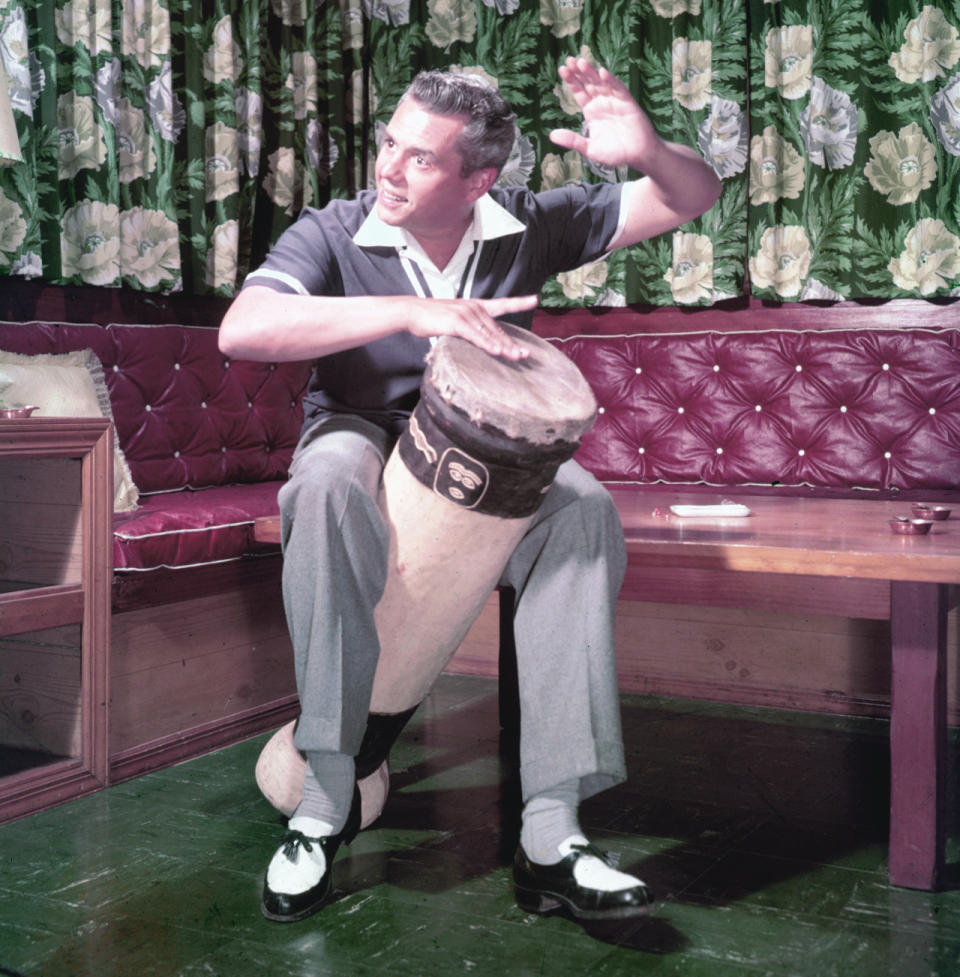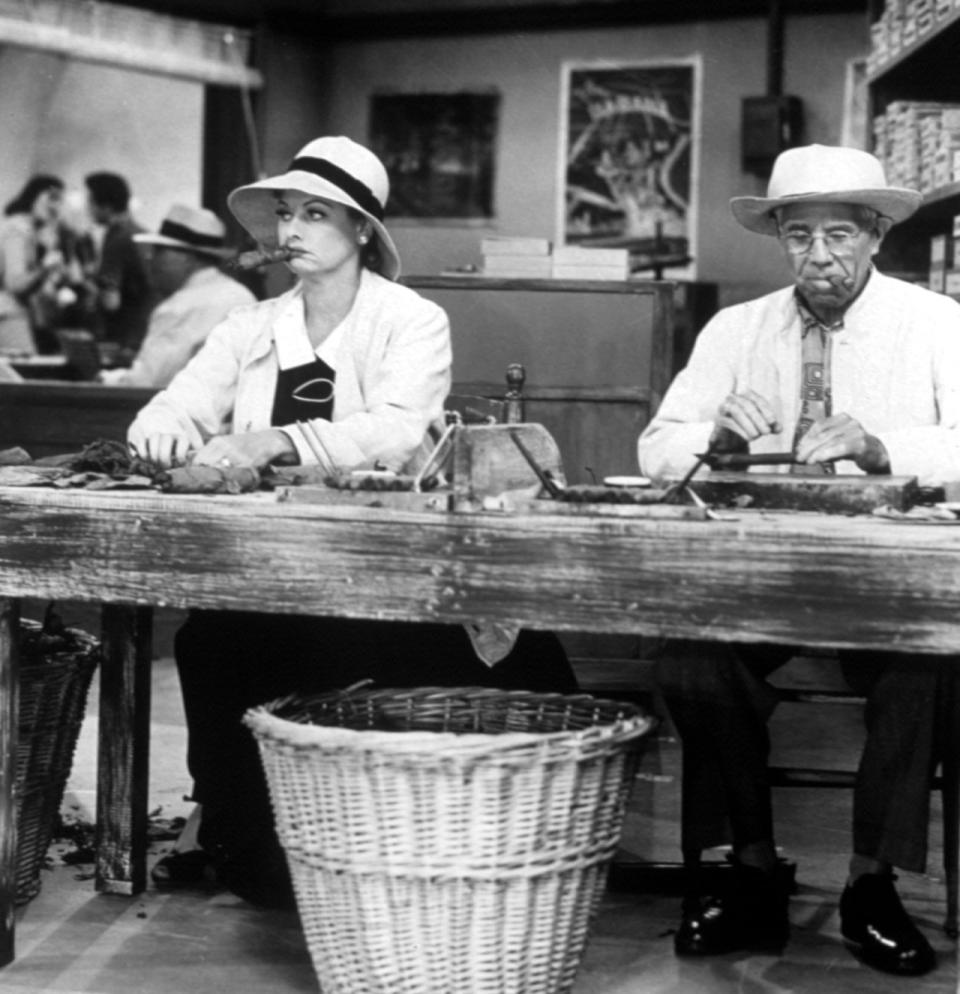‘I Love Lucy’ and the Cuba of America’s dreams

Lucille Ball and her husband, Desi Arnaz, on the set of “I Love Lucy,” circa 1955. (Photo: CBS Photo Archive/Getty Images)
If you were a typical American in the early 1950s, you probably thought you knew Cuba pretty well. You knew it was a country of dangerously handsome nightclub singers given to hilarious malapropisms in broken English, and of brassy, rumba-dancing sirens in slit dresses and fruit-salad headdresses. You knew the people lived among chickens and burros while strumming “Cielito Lindo” on their guitars. You knew all this, even if it wasn’t remotely accurate, because you saw it on “I Love Lucy,” in its time the most popular program on television, a cultural force so powerful it created its own reality. Although set in New York and filmed in a Hollywood studio, “Lucy” invented, through the character of Ricky Ricardo, a fictitious Cuba that loomed as large in American culture as any Latin American country save Mexico.
It almost didn’t happen that way. In 1950, when CBS sought to move Lucille Ball’s popular radio program to television, the star insisted on casting her actual husband, Cuban bandleader Desi Arnaz, as her on-screen spouse. According to James Sheridan, the unofficial “I Love Lucy” scholar-in-residence at the Paley Center for Media in New York, the response by the network amounted to: “Forget it — nobody will believe you’re married to him.”

Desi Arnaz as Ricky Ricardo in “I Love Lucy,” circa 1955. (Photo: Silver Screen Collection/Getty Images)
“She said, ‘But I am married to him,’” Sheridan recounts, and to prove her point, she embarked on a months-long national tour with Arnaz and his orchestra, whose success persuaded CBS to go along with the then daring notion of portraying the marriage of a redheaded American beauty and a member of an ethnic group that would later be called Hispanic. Sheridan points out that in the early years of television, audiences didn’t balk at the appearance of ethnic minorities in situation comedies, nor were the networks especially concerned about political correctness in exploiting stereotypes for laughs. Contemporaneous series included “Amos ’n’ Andy,” “The Goldbergs,” “Life With Luigi” and even “I Remember Mama,” about a family from that exotic land of … whatever it was that Norway was known for at the time. It wasn’t until the latter half of the decade that they were elbowed aside by the Cleavers and Nelsons and the rest of the all-American sitcom families we think of as quintessentially 1950s.
It undoubtedly helped that Arnaz, a descendant of Spanish nobility, was, to put it directly, a white man — albeit one who would exclaim, “Now, Loosy, take-a-tizzy!” when he was trying to calm his wife. Arnaz’s accent and mispronunciations were more than a running joke in “I Love Lucy”; they were the key to the character of Ricky Ricardo, who believed he was fitting smoothly into American society even as he struggled with its most basic requirement. At moments of high emotion, he would erupt into bursts of rapid-fire Spanish that were usually left untranslated; no line of dialogue could be funnier than the cascade of long vowels and clipped sibilants he poured down on his uncomprehending wife. It would not be an exaggeration to say that the first words of Spanish many Americans heard spoken were by Arnaz (or that the first Spanish words whose meaning they understood were Lucy’s hesitant efforts to wrap her tongue around a word for “thank you” she pronounced “grassy-ass”).
Arnaz “really did talk like that,” Sheridan says. “In fact, some people said he was harder to understand when he was talking to you in real life.” But he was an actor; writers quickly discovered that if they tried to write dialogue the way they thought Arnaz would mispronounce it, he crossed them up by saying the lines correctly. And it became a rule that the only character allowed to make fun of Arnaz’s accent was Lucy herself, perhaps because her on-screen Spanish was, if anything, worse than his English.
Although Americans could visit Cuba freely in those years, the producers didn’t see a need to waste money on actually filming there. It wasn’t until the sixth and final season of “I Love Lucy,” in 1956 — the same characters appeared for several years thereafter in a series of one-hour specials — that the Ricardos get around to paying a visit to Havana, and much of that episode was actually set in a hotel room where Lucy meets Ricky’s family. (Spoiler alert: Lucy sits on Uncle Alberto’s cigars.) According to Sheridan, for almost a decade after Castro took power, CBS — sensitive to the explosive political implications of depicting a visit to the forbidden island, by fictitious characters, set before the revolution, and not actually filmed there at all — refused to air the episode in reruns.

Lucille Ball in the “I Love Lucy” episode “The Ricardos Visit Cuba,” which aired Dec. 3, 1956. (Photo: Everett Collection)
The notional Cuba of “I Love Lucy” was exotic in ways small and large. In one early episode, the Ricardos and their sidekicks, Fred and Ethel Mertz, open a diner, serving a “Little Bit of Cuba” special that could only have been concocted as a way to discourage Americans from traveling there: a hamburger smothered in Tabasco, with mashed bananas, served between two tortillas. Probably no more than a handful of viewers knew that when Arnaz picked up his conga drum for his signature number, “Babalu,” he was actually intoning a prayer to the Santeria deity Babalú-Ayé, the god of disease and healing. But in the character of Ricky, the exotic mixed with the domesticated, a television dad who worried about paying the bills and tried to impose some notion of practicality on his zany television wife. He was viewed by Americans, according to the astute Cuban journalist Alfredo Prieto, “with a mixture [of] exoticism, assimilationism and paternalism.” Those were not qualities that would later endear him to Fidel Castro who, after taking power, made one of the world’s most famous Cuban expatriates a nonperson in his home country. In an era when foreign travel was an exotic luxury, “I Love Lucy” was the lens through which mid-century Americans viewed the alluring, tropical Neverland they hoped to visit someday. As history turned out, most never got there.




